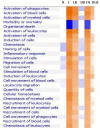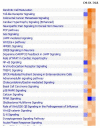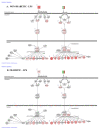Dysregulation of Gene Expression of Key Signaling Mediators in PBMCs from People with Type 2 Diabetes Mellitus
- PMID: 36769056
- PMCID: PMC9916932
- DOI: 10.3390/ijms24032732
Dysregulation of Gene Expression of Key Signaling Mediators in PBMCs from People with Type 2 Diabetes Mellitus
Abstract
Diabetes is currently the fifth leading cause of death by disease in the USA. The underlying mechanisms for type 2 Diabetes Mellitus (DM2) and the enhanced susceptibility of such patients to inflammatory disorders and infections remain to be fully defined. We have recently shown that peripheral blood mononuclear cells (PBMCs) from non-diabetic people upregulate expression of inflammatory genes in response to proteasome modulators, such as bacterial lipopolysaccharide (LPS) and soybean lectin (LEC); in contrast, resveratrol (RES) downregulates this response. We hypothesized that LPS and LEC will also elicit a similar upregulation of gene expression of key signaling mediators in (PBMCs) from people with type 2 diabetes (PwD2, with chronic inflammation) ex vivo. Unexpectedly, using next generation sequencing (NGS), we show for the first time, that PBMCs from PwD2 failed to elicit a robust LPS- and LEC-induced gene expression of proteasome subunit LMP7 (PSMB8) and mediators of T cell signaling that were observed in non-diabetic controls. These repressed genes included: PSMB8, PSMB9, interferon-γ, interferon-λ, signal-transducer-and-activator-of-transcription-1 (STAT1), human leukocyte antigen (HLA DQB1, HLA DQA1) molecules, interleukin 12A, tumor necrosis factor-α, transporter associated with antigen processing 1 (TAP1), and several others, which showed a markedly weak upregulation with toxins in PBMCs from PwD2, as compared to those from non-diabetics. Resveratrol (proteasome inhibitor) further downregulated the gene expression of these inflammatory mediators in PBMCs from PwD2. These results might explain why PwD2 may be susceptible to infectious disease. LPS and toxins may be leading to inflammation, insulin resistance, and thus, metabolic changes in the host cells.
Keywords: IFN-γ; LPS; NGS; NO; cytokines; lectins; resveratrol; signal transduction; type 2 diabetes.
Conflict of interest statement
The authors declare no conflict of interest.
Figures










Similar articles
-
Reprograming of Gene Expression of Key Inflammatory Signaling Pathways in Human Peripheral Blood Mononuclear Cells by Soybean Lectin and Resveratrol.Int J Mol Sci. 2022 Oct 26;23(21):12946. doi: 10.3390/ijms232112946. Int J Mol Sci. 2022. PMID: 36361735 Free PMC article.
-
Type I interferon signaling in systemic immune cells from patients with alcoholic cirrhosis and its association with outcome.J Hepatol. 2017 May;66(5):930-941. doi: 10.1016/j.jhep.2016.12.008. Epub 2016 Dec 28. J Hepatol. 2017. PMID: 28040548
-
SOCS3 Regulates Dectin-2-Induced Inflammation in PBMCs of Diabetic Patients.Cells. 2022 Aug 28;11(17):2670. doi: 10.3390/cells11172670. Cells. 2022. PMID: 36078084 Free PMC article.
-
Impact of Sodium Butyrate Treatment in LPS-Stimulated Peripheral Blood Mononuclear Cells of Poorly Controlled Type 2 DM.Front Endocrinol (Lausanne). 2021 Jul 29;12:652942. doi: 10.3389/fendo.2021.652942. eCollection 2021. Front Endocrinol (Lausanne). 2021. PMID: 34393993 Free PMC article.
-
microRNA-143-3p contributes to inflammatory reactions by targeting FOSL2 in PBMCs from patients with autoimmune diabetes mellitus.Acta Diabetol. 2021 Jan;58(1):63-72. doi: 10.1007/s00592-020-01591-9. Epub 2020 Aug 20. Acta Diabetol. 2021. PMID: 32815005
References
-
- Jesenak M., Brndiarova M., Urbancikova I., Rennerova Z., Vojtkova J., Bobcakova A., Ostro R., Banovcin P. Immune parameters, and COVID-19 infection-associations with clinical severity and diseases prognosis. Front. Cell. Infect. Microbiology. 2020;10:364. doi: 10.3389/fcimb.2020.00364. - DOI - PMC - PubMed
-
- Siddiqui A.A., Siddiqui S.A., Ahmad S., Siddiqui S., Ahsan I., Sahu K. Diabetes: Mechanism, pathophysiology, and management-A review. Int. J. Drug Dev. Res. 2013;5:1–23.
MeSH terms
Substances
Grants and funding
LinkOut - more resources
Full Text Sources
Medical
Research Materials
Miscellaneous

